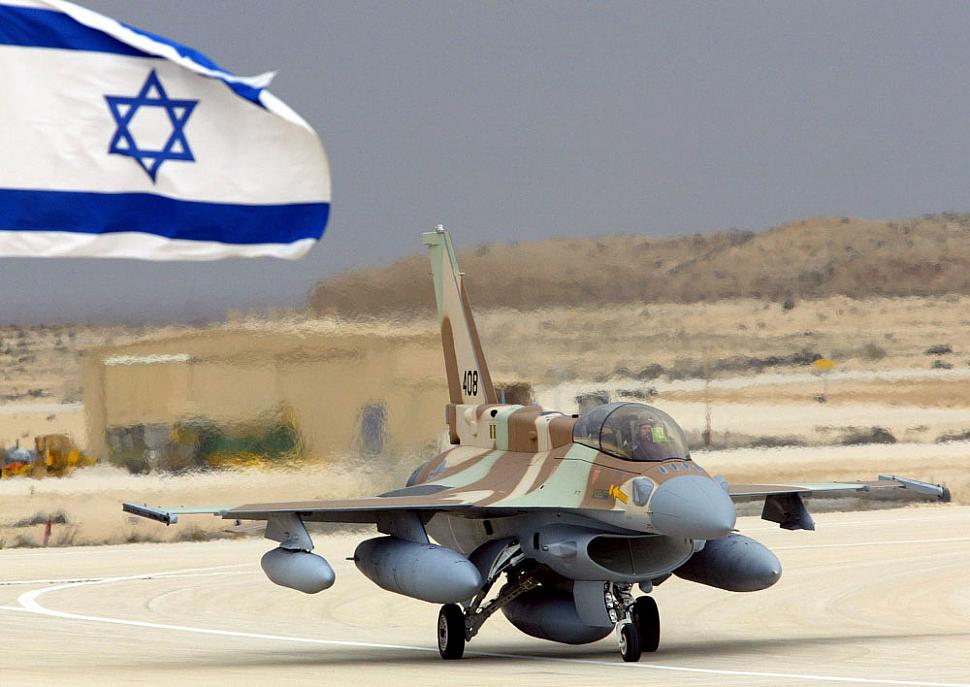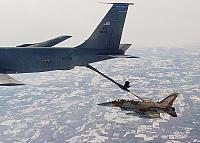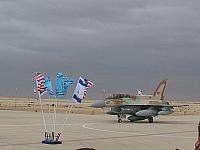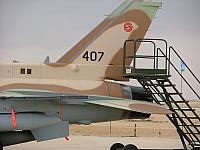Fighter Jet News
F-16 Fighting Falcon News
First F-16I 'Sufa' jets arrived in Israel
February 19, 2004 (by
Lieven Dewitte) -
The first two of Israel's newest F-16I fighter jets (408, 409) landed at the Mizpe Ramon Israel Air Force base in the Negev this afternoon. It is the first batch of a total of 102 planes Israel has ordered from the United States. Named the Sufa ('Storm'), the two-seater jets form the first batch of a total of 102 planes Israel has ordered from the United States.
The two planes left the Lockheed Martin's manufacturing facility in Fort Worth, Texas, on Tuesday, and after a stopover in the Azores, arrived in Israel today. Subsequent deliveries of the jet will occur at a rate of two per month over the next four years.
When delivery of the jets is completed, Israel will have a total of 362 F-16s, the second-largest F-16 fleet only to the United States Air Force.
A 'totally different world'
According to Israeli pilots who have already flown them in simulation, it is a "totally different world." They assumed that although the operational systems would be different, ate least the general feeling would be similar to that of their previous flights. However, they were shocked to find the plane a lot stronger and more powerful.
"Going over to fly a Sufa jet, after flying the existing F-16, is like starting to drive an American luxury car after you're used to an old, dilapidated Subaru," said Maj. H., an IAF pilot, quoted in Yediot Aharonot.
The pilot said the Sufa was able to fly low and in all weather conditions, almost without manual intervention. It was able to avoid being detected by enemy radar, and return home safely from its missions.
Production and preparation
The F-16Is are rolling off of the production line at Lockheed Martin's plant in Ft. Worth, Texas at a steady pace. They are being assembled next to F-16s for the United Arab Emirates and Greece.
The first F-16I jets were rolled out in November, in a ceremony attended by Defense Minister Shaul Mofaz. The planes were acquired through the U.S. government's Peace Marble V program and they cost about $45 million per plane. The order, the largest Israeli military purchase in history, is being paid for from the annual US military grant given to Israel, which this year stands at about $2.2 billion.
Preparations to accept the new planes and form the four new squadrons have been underway for two years. The pilots and ground crew have spent the last several months in the U.S., where they have undergone training in simulators. They have also been learning from American veteran pilots of the Vietnam War. According to one of the trainees, "it was like your grandfather teaching you to fly."
The squadron is made up of veteran pilots who have already proven themselves in other jets.
Range includes targets in Iran and Libya
The F-16s are the backbone of the IAF, but these new "I" models will considerably boost the IAF's long-arm reach, enabling it to fly a round trip of 1,040 miles (1,640 kilometres).This extended flight range enables the IAF to attack targets well within Iran and Libya without having to refuel. The additional removable fuel tanks (CFT's) which it has for that purpose, do not affect the maneuverability.
When Israel signed the deal in 1999, Iraq was still a formidable power run by Saddam Hussein with alleged nuclear pretensions. Iran was quickly building long-range rockets and nuclear weapons and Libya was trying its best to purchase them. This has changed bringing into question the wisdom of purchasing three squadrons.
The Sufa is powered by the Pratt and Whitney F100-PE-229 Improved Performance Engine. The aircraft is designed for gross takeoff gross weight of 52,000 pounds (23,582 kg), which means it can haul more weaponry than older F-16s. Flying at its highest altitude and fastest speed, the Sufa can fly from Metulah to Eilat in 5-10 minutes.
New technology
The cockpit has two seats - for the pilot and for the weapons engineer who "flies the bombs" down to the targets once they are released. The computer displays are in color and three-dimensional, such that you can know exactly where you are. The plane can fly at very low altitudes, even at night and in bad weather, enabling the plane to avoid enemy radar and its weapons systems are the most advanced in the world.
The new plane is a combination of the skeleton of the F-16, Israeli technology and innovations appropriate specifically for that region. Because the Sufa has been supplemented to Israel's specifications it is different from any other F-16 in the world. It has been customized with new avionic technologies, internally mounted FLIR (forward looking infrared) viewers, and cutting edge weapon system hardware that allows for simultaneous, multi-target air-to-air engagement and increased standoff and survivability capabilities.
The F-16I has also been earmarked to receive the new Python 5 imaging infrared-guided high agility air-to-air missile produced by Rafael, which has a new seeker less prone to countermeasures, lock-after-launch capabilities, and an extended operational engagement time once fired.
In addition, the Northrop Grumman AN/APG-68(V)9 multimode radar increases the distance of airborne engagement by 30% over the older APG-69 system and affords the Sufah with a high-resolution synthetic-aperture ground mapping capability.
Israeli companies equip new jet
Israeli companies participating in the F-16I program are as follows:
When delivery of the jets is completed, Israel will have a total of 362 F-16s, the second-largest F-16 fleet only to the United States Air Force.
A 'totally different world'
According to Israeli pilots who have already flown them in simulation, it is a "totally different world." They assumed that although the operational systems would be different, ate least the general feeling would be similar to that of their previous flights. However, they were shocked to find the plane a lot stronger and more powerful.
"Going over to fly a Sufa jet, after flying the existing F-16, is like starting to drive an American luxury car after you're used to an old, dilapidated Subaru," said Maj. H., an IAF pilot, quoted in Yediot Aharonot.
The pilot said the Sufa was able to fly low and in all weather conditions, almost without manual intervention. It was able to avoid being detected by enemy radar, and return home safely from its missions.
Production and preparation
The F-16Is are rolling off of the production line at Lockheed Martin's plant in Ft. Worth, Texas at a steady pace. They are being assembled next to F-16s for the United Arab Emirates and Greece.
The first F-16I jets were rolled out in November, in a ceremony attended by Defense Minister Shaul Mofaz. The planes were acquired through the U.S. government's Peace Marble V program and they cost about $45 million per plane. The order, the largest Israeli military purchase in history, is being paid for from the annual US military grant given to Israel, which this year stands at about $2.2 billion.
Preparations to accept the new planes and form the four new squadrons have been underway for two years. The pilots and ground crew have spent the last several months in the U.S., where they have undergone training in simulators. They have also been learning from American veteran pilots of the Vietnam War. According to one of the trainees, "it was like your grandfather teaching you to fly."
The squadron is made up of veteran pilots who have already proven themselves in other jets.
Range includes targets in Iran and Libya
The F-16s are the backbone of the IAF, but these new "I" models will considerably boost the IAF's long-arm reach, enabling it to fly a round trip of 1,040 miles (1,640 kilometres).This extended flight range enables the IAF to attack targets well within Iran and Libya without having to refuel. The additional removable fuel tanks (CFT's) which it has for that purpose, do not affect the maneuverability.
When Israel signed the deal in 1999, Iraq was still a formidable power run by Saddam Hussein with alleged nuclear pretensions. Iran was quickly building long-range rockets and nuclear weapons and Libya was trying its best to purchase them. This has changed bringing into question the wisdom of purchasing three squadrons.
The Sufa is powered by the Pratt and Whitney F100-PE-229 Improved Performance Engine. The aircraft is designed for gross takeoff gross weight of 52,000 pounds (23,582 kg), which means it can haul more weaponry than older F-16s. Flying at its highest altitude and fastest speed, the Sufa can fly from Metulah to Eilat in 5-10 minutes.
New technology
The cockpit has two seats - for the pilot and for the weapons engineer who "flies the bombs" down to the targets once they are released. The computer displays are in color and three-dimensional, such that you can know exactly where you are. The plane can fly at very low altitudes, even at night and in bad weather, enabling the plane to avoid enemy radar and its weapons systems are the most advanced in the world.
The new plane is a combination of the skeleton of the F-16, Israeli technology and innovations appropriate specifically for that region. Because the Sufa has been supplemented to Israel's specifications it is different from any other F-16 in the world. It has been customized with new avionic technologies, internally mounted FLIR (forward looking infrared) viewers, and cutting edge weapon system hardware that allows for simultaneous, multi-target air-to-air engagement and increased standoff and survivability capabilities.
The F-16I has also been earmarked to receive the new Python 5 imaging infrared-guided high agility air-to-air missile produced by Rafael, which has a new seeker less prone to countermeasures, lock-after-launch capabilities, and an extended operational engagement time once fired.
In addition, the Northrop Grumman AN/APG-68(V)9 multimode radar increases the distance of airborne engagement by 30% over the older APG-69 system and affords the Sufah with a high-resolution synthetic-aperture ground mapping capability.
Israeli companies equip new jet
Israeli companies participating in the F-16I program are as follows:
- Israel Aircraft Industries (IAI) makes wings, tail sections, inline fuel tanks, satellite communications systems, and tactical data communications systems.
- Elbit Systems makes the head-up display (HUD), helmet display, mission computer, presentation computer and digital map, elevators, ailerons, fuselage stabilizers, and doors.
- Rafael makes the avionics suite, ground following algorithm software, and communications equipment.
- Elisra Electronic Systems makes the defense suite against radar locking, radar-guided and heat-seeking missiles.
- BAE Systems Rokar International makes external heat dissipaters and flares.
- Rada Electronic Industries makes ground debriefing systems.
Additional images:
Related articles:
Forum discussion:
Tags
- First flight of the F-16I (2003-12-24)
- First F-16I Sufa ready for delivery to Israel (2003-11-26)
- Lockheed Martin completes first F-16I for Israel (2003-11-14)
- Rollout of first Israeli F-16I scheduled for next week (2003-11-08)
- F-16 Fighting Falcon news archive
Forum discussion:
- First F-16I 'Sufa' jets arrived in Israel ( 1 replies)
Tags




